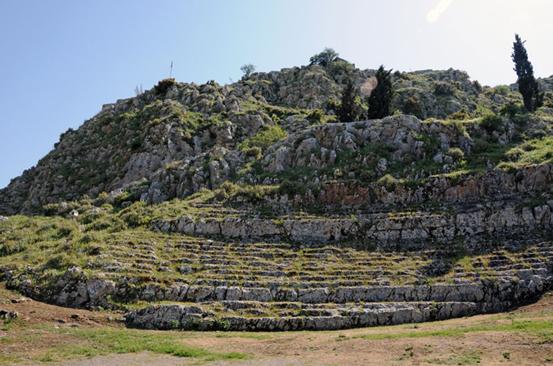
|
| ANCIENT THEATRE OF CHAERONEA |
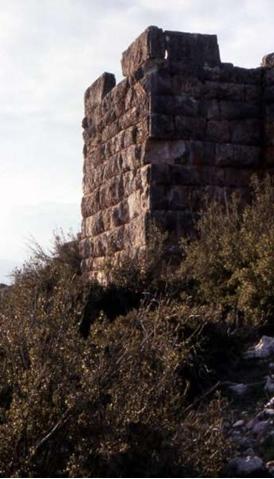
|
| CITADEL OF PANOPEIA (CHAERONEA) |
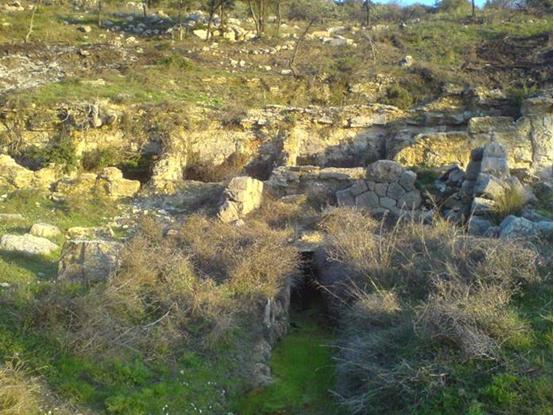
|
| SANCTUARY OF PTOOS APOLLO |
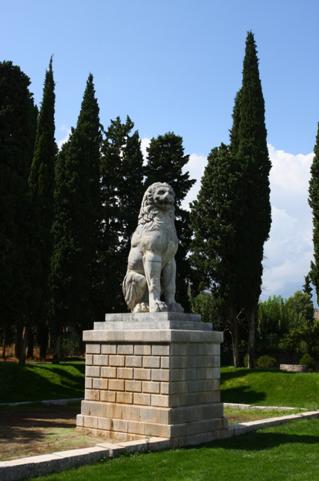
|
| THE LION OF CHAERONEA |
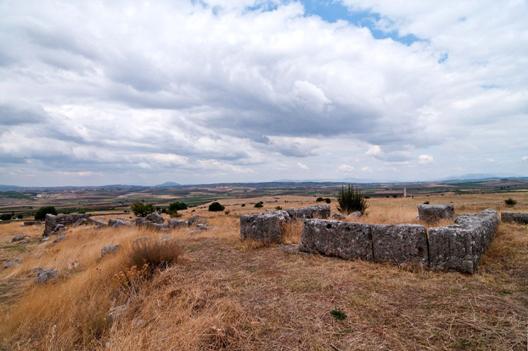
|
| PLATAEA |
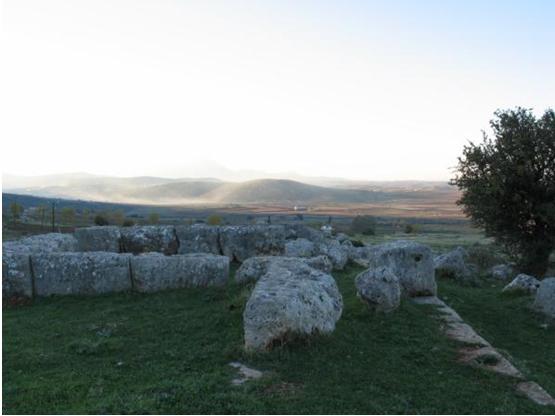
|
| PLATAEA |
|
ANCIENT THEBES
The modern city of Thebes is built at the place of Ancient Thebes, one of the most important cities of the antiquity. The area was inhabited in the Neolithic period and it flourished especially during the Mycenaean period. At a distance of 45 kilometers from Livadeia, in the Mycenaean citadel of Thebes, Kadmeia, the remains of the ancient civilization are still visible. The fortification was constructed with boulders on the natural rock. Only some parts of the wall do still exist. The Mycenaean Palace, the Temple of Apollo Ismenius and the gates of Kadmeia are of the most important monuments.
The Mycenaean Palace, otherwise called Kadmeion, dates back to the 13th century BC and it is approximately in the centre of the citadel. It was decorated with wall paintings and furthermore ceramic tablets of Linear B’ and amphorae have been also found. The palace was destroyed by a fire in about 1200 BC.
The Temple of Apollo Ismenius was constructed after the victory in Leuctra in 371 BC and it belongs to the greatest worshipping of Thebes, along with the one of Demeter Thesmophoros. Prior to this temple, there was the archaic and geometrical temple at the same location. Nowadays some parts of the ceramic antefixes are preserved.
From the seven mythological gates of the citadel only two are preserved. They are on the east side of the city and they bear the basic characteristics of the Mycenaean fortifying art. The rest gates are placed based on t exits of the city towards various locations of Boeotia.
THE SANCTUARY OF KAVEIRA
Just 8 kilometers west from Thebes, there is the Sanctuary of Kaveira, which is devoted to two deities of unknown origin, Kaveiros and Pais. Kaveiroi were considered the protectors of the vineyard and the fertility of animals. This is indicated by the depictions of bulls that were found there. This sanctuary had been used for worshipping from the roman years until the Post Christian Roman period. The temple had an outdoor yard with two altars for sacrifices.
On the eats of the temple there are the ruins of small ancient theatre. It was used during the Hellenistic period and it had no stage. It consisted of an auditorium (“koilon”) of ten sections of seating (“kerkides”) and an altar in the centre of the orchestra. The small theatre was used for events that were addressed to religious people.
SANCTUARY OF PTOOS APOLLO
Just three kilometers east of Akraifnio, on a side of Mount Ptoos, there is the Sanctuary of Ptoos Apollo. The sanctuary used to depend on Thebes, and it is thus considered that it was built after the reconstruction of Thebes during the period of Cassander, in 316 BC. At this point there was an older temple from which very few ruins still exist. The most modern temple dates back to the end of the 4th century BC. There was also an oracle in the area, which was known throughout Boeotia. Every five years there were organized poetical and theatrical games, called Ptoia. The games were combined with religious ceremonies and sacrifices. Bronze oblations, vessels, pots and many statuettes devoted to Apollo were found in the sanctuary.
PLATAEA
The Battle of Plataea, in 479 BC, is of great historical importance not only to Boeotia, but to the whole of Greece, as well as to Europe. Historians consider that the victory of Greeks saved the Greek civilization. At the foot of Mount Kithairon the battle field has become an archaeological site.
Nowadays, some parts of the fortifying surrounding of Ancient Plataea are preserved; others date back to the 4th century BC and others to the prehistoric period. Several towers, built in the yard, are also preserved. Inside the fortress, on the northwest side, there is the Temple of Hera of Doric order. Inside the temple there was Hera’s statue, created by Praxiteles. Moreover the foundations of the altar that was built by the Greeks after the battle, as requested by Delphi oracle, do still exist. After a visit to the archaeological site, you can understand the historical importance of the battle.
ANCIENT TANAGRA
On the southeast side of Boeotia, there was its most important city during the antiquity. It is estimated that the area was inhabited in the 14th century BC and it flourished in the period from the Mycenaean until the roman era. The citadel of Tanagra was fortified with walls, which seem to have had embedded towers at several points. Inside the walls there was the sanctuary of Dionysus, with the worshipped statue, created by famous Praxiteles, as well as another statue. Near that temple there were the temples of Apollo, Aphrodite Themis and Hermes. There are also cemeteries in the area, which have been excavated from the archaic to the early roman period. Tanagra was known for its developed plastic arts, because the earthen statuettes called Tanagra daughters were created there. The citadel is 5 kilometers away from the modern village of Tanagra.
CITADEL OF PANOPEIA (CHAERONEA)
At a distance of 18 kilometers from Livadeia, in the area of Chaeronea, Agios Vlasios village has been built at the location of the ancient city of Panopeia. According to the mythology the road that lead to Delphi passed across that point, and it was considered that Apollo had used that road on his way to Delphi. It is said that the city was inhabited in the 18th century BC and some centuries later it acquired strong fortification.
In 346 BC it was destroyed by the army of Phillip II, and that made the residents of the area fortify it with strong walls, just before the final battle with the Macedonians in 338 BC, in Chaeronea. Built with large, rectangular stones the walls enclosed the city of Panopeas as well as a part of the valley. The city was looted again by the army of Mithridates, in 86 BC. Several parts of the wall and some surrounding towers of the Mycenaean period are still preserved. It has three entrances, on the north, on the west as well as on the south side.
ANCIENT THEATRE OF CHAERONEA
Very close to the citadel of Chaeronea there is the ancient theatre, devoted to the worshipping of Dionysus. Ancient Chaeronea had been inhabited since the Neolithic period and the theatre is considered that was first used in the end of the 5th century BC. It is fully harmonized with the environment since it is engraved on the natural rock.
The ancient theatre of Chaeronea, being very simple, apart from performances, was generally used for the meetings of citizens. Even though it was constructed in the 5th century BC, it shows enough reconstruction phases. In the end of the 4th century BC the theatre was reformed and got a semi-circular shape. Until then, probably it did not have a stage, but it is considered that wooden stages were placed at each performance. What is preserved nowadays is what remained from the final phase of the theatre, in the roman period, when many works took place and its capacity grew. There is also a part of the auditorium (“koilon”) and some seats (“edolia”) engraved on the rock. At the entrance of the archaeological site there is a stone-built spring, constructed in 1865, with embedded ancient material.
THE LION OF CHAERONEA
At the entrance of Chaeronea, 13 kilometers away from Livadeia, there is a marble pedestal with a big lion. This funerary monument was erected in honor of the Sacred Band of Thebes who died in the Battle of Chaeronea in 338 BC, in which the Macedonians were the winners. When Phillip II allowed the burial of the dead after his victory, the Lion of Chaeronea was erected to indicate the burial location. Indeed, the excavations revealed the skeletons of 254 men and a part of their weaponry.
It is 5,30 meters tall and it seems to be sitting on its back feet. The lion is considered to symbolize the heroism of the soldiers of Thebes, which had been acknowledged even by Phillip II himself. The ion was revealed, after some excavations, in 1818; its five parts were found and it was reconstructed on a 3 meter tall base. Currently, it is next to the Archaeological Museum of Chaeronea in front of a row of cypresses.
ARCHAEOLOGICAL SITE OF ORCHOMENUS
The modern small market town of Orchomenus is built near the area where the ancient, fortified citadel was. The fortification of ancient Orchomenus includes the ancient theatre and the beehive tomb of Minyas. The fortification is constructed all around a hill. On top of the hill, there is still the giant Tower, built with boulders. The two big castle gates are still preserved. The walls of the citadel had been completely destroyed by the Thebans in 364 BC, and were reconstructed by Phillip II after the Battle of Chaeronea.
The ancient theatre of Orchomenus is built on the slope. Its construction dates back to the 4th century BC, in the beginning of the Hellenistic period. The “koilon” of the theatre is towards the east, while there are no seating rows (“diazomata”). The front seats (“edrana”), with the embossed decoration, are still preserved. The monument has not been systematically excavated. However, it is considered that the theatre hosted Charitisia, musical, theatrical, poetical and rhetoric games in honor of Charites. Charites were the most important deities in the area.
The beehive tomb of Minyas is at the east foot of the hill and it is surrounded by the walls. The purpose of its construction has not been clarified yet; however it suggests the great art skills of Minyans. It is of marble and it consists of a ditch, an entrance which leads to a circular building with a conical roof and the chamber. The beehive tomb of Minyas is regarded as one of the most important architectural monuments worldwide, due to its construction.
|

 Attractions / Destinations
Attractions / Destinations
 Archaeological Sites
Archaeological Sites



